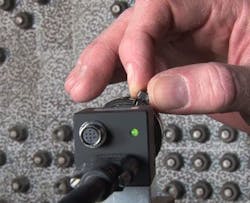Stereo vision helps build better bridges
A National Institute of Standards and Technology (NIST; Gaithersburg, MD, USA) researcher has been helping to ensure the safety of hundreds of truss bridges across the US using a stereo vision system.
Material scientist Mark Iadicola is on a team that is using the system to analyze how speckles painted on bridge components move, enabling him to determine how the metal behaves under stress and strain.
The impetus for the project was the disastrous collapse of the Interstate 35W bridge in Minneapolis, MN on Aug. 1, 2007, when -- in the middle of the evening rush hour -- a thousand feet of the bridge's main deck truss collapsed, causing part of it to fall into the Mississippi River.
According to the National Transportation Safety Board (NTSB), a design flaw in a metal connector called the gusset plate -- a flat, heavy piece of steel bolted in pairs to join the ends of the steel members that make up the bridge truss -- was the cause. The gusset plates in the bridge were about half as thick as they should have been.
As a result, the Federal Highway Administration (FHWA), in cooperation with the American Association of State Highway and Transportation Officials (AASHTO), decided to scientifically determine what it takes for gusset plate to fail, not only under their expected load conditions but also in extreme cases where a bridge would be exposed to conditions for which it was not originally designed.
At the FHWA test facility in McLean, VA, massive hydraulic jacks are used to apply a force to gusset plates under test. And to measure the effect of that force, the FHWA uses not one but three different systems to provide a complete picture of what stress does to the plates.
However, while the first two strain gauges and photoelasticity techniques are adequate at measuring the normal range of stress in which the plate will stretch and spring back to its original shape, they are not as effective at measuring the more dramatic strains that lead to metal weakness and failure.
That's where NIST stepped in to help. Its digital imaging system uses two high-resolution cameras to stereoscopically record a pattern painted in the gusset plate. The cameras repeatedly image the plate, send the pictures to a computer that uses custom software to compare each image to the previous one, and calculate which of the paint spots have moved, in what direction, and by how much.
Using two cameras allows the computer to "see" the plate in three dimensions, so it can tell if points on the surface move in or out as well as up, down, or sideways as stress is applied. That data can be continuously captured until the plate fails either through buckling or some other mechanism.
After more than a year of experiments, the FHWA has learned a lot about how to predict what loads will cause a gusset plate to fail. Currently, FHWA is working with AASHTO to translate those findings into language that can be adopted into the AASHTO Bridge Design Specification and Manual for Bridge Evaluation, two documents used throughout the US for designing and load rating bridges.
-- By Dave Wilson, Senior Editor, Vision Systems Design
